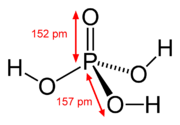Phosphoric acid
Phosphoric acid, also known as orthophosphoric acid or phosphoric(V) acid, is a weak acid with the chemical formula H
3PO
4. It is normally encountered as a colorless syrup of 85% concentration in water. The pure compound is a colorless solid.
 | |||
| |||
| Names | |||
|---|---|---|---|
| IUPAC name
Phosphoric acid | |||
| Other names
Orthophosphoric acid | |||
| Identifiers | |||
3D model (JSmol) |
|||
| ChEBI | |||
| ChEMBL | |||
| ChemSpider | |||
| ECHA InfoCard | 100.028.758 | ||
| EC Number |
| ||
| E number | E338 (antioxidants, ...) | ||
| KEGG | |||
PubChem CID |
|||
| RTECS number |
| ||
| UNII | |||
| UN number | 1805 | ||
CompTox Dashboard (EPA) |
|||
| |||
| |||
| Properties | |||
| H 3PO 4 | |||
| Molar mass | 97.994 g·mol−1 | ||
| Appearance | colorless syrup | ||
| Odor | Odorless | ||
| Density | 1.6845 g⋅cm−3 (25 °C, 85%),[1] 1.834 g⋅cm−3 (solid)[2] | ||
| Melting point | 40–42.4 °C (104.0–108.3 °F; 313.1–315.5 K)[3] | ||
| Boiling point | 212 °C (414 °F; 485 K)[4] | ||
| Solubility | Soluble in ethanol | ||
| log P | −2.15[6] | ||
| Vapor pressure | 0.03 mmHg (20 °C)[7] | ||
| Conjugate base | Dihydrogen phosphate | ||
| −43.8·10−6 cm3/mol[8] | |||
Refractive index (nD) |
| ||
| Viscosity | 2.4–9.4 cP (85% aq. soln.) 147 cP (100%) | ||
| Structure | |||
| Monoclinic | |||
| Tetrahedral | |||
| Thermochemistry[10] | |||
Heat capacity (C) |
145.0 J/mol⋅K | ||
Std molar entropy (S |
150.8 J/mol⋅K | ||
Std enthalpy of formation (ΔfH⦵298) |
−1271.7 kJ/mol | ||
Gibbs free energy (ΔfG˚) |
-1123.6 kJ/mol | ||
| Hazards | |||
| Safety data sheet | ICSC 1008 | ||
| GHS pictograms |  | ||
| GHS Signal word | Danger | ||
GHS hazard statements |
H290, H314[11] | ||
| P280, P305+351+338, P310[11] | |||
| NFPA 704 (fire diamond) | |||
| Flash point | Non-flammable | ||
| Lethal dose or concentration (LD, LC): | |||
LD50 (median dose) |
1530 mg/kg (rat, oral)[12] | ||
| NIOSH (US health exposure limits): | |||
PEL (Permissible) |
TWA 1 mg/m3[7] | ||
REL (Recommended) |
TWA 1 mg/m3 ST 3 mg/m3[7] | ||
IDLH (Immediate danger) |
1000 mg/m3[7] | ||
| Related compounds | |||
Related phosphorus oxoacids |
| ||
Except where otherwise noted, data are given for materials in their standard state (at 25 °C [77 °F], 100 kPa). | |||
| Infobox references | |||
All three hydrogens are acidic to varying degrees and can be lost from the molecule as H+ ions (protons). When all three H+ ions are removed, the result is an orthophosphate ion PO43−, commonly called "phosphate". Removal of one or two protons gives dihydrogen phosphate ion H
2PO−
4, and the hydrogen phosphate ion HPO2−
4, respectively. Orthophosphoric acid also forms esters, called organophosphates.[13]
Phosphoric acid is commonly encountered in chemical laboratories as an 85% aqueous solution, which is a colourless, odourless, and non-volatile syrupy liquid. Although phosphoric acid does not meet the strict definition of a strong acid, the 85% solution can still severely irritate the skin and damage the eyes.
The name "orthophosphoric acid" can be used to distinguish this specific acid from other "phosphoric acids", such as pyrophosphoric acid. Nevertheless, the term "phosphoric acid" often means this specific compound; and that is the current IUPAC nomenclature.
Manufacture
Phosphoric acid is produced industrially by two general routes.[14] In the wet process a phosphate-containing mineral such as calcium hydroxyapatite is treated with sulfuric acid.[15]
Fluoroapatite is an alternative feedstock, in which case fluoride is removed as the insoluble compound Na2SiF6. The phosphoric acid solution usually contains 23–33% P2O5 (32–46% H3PO4). It may be concentrated to produce commercial- or merchant-grade phosphoric acid, which contains about 54–62% P2O5 (75–85% H3PO4). Further removal of water yields superphosphoric acid with a P2O5 concentration above 70% (corresponding to nearly 100% H3PO4). Calcium sulfate (gypsum) is produced as a by-product and is removed as phosphogypsum.
To produce food-grade phosphoric acid, phosphate ore is first reduced with coke in an electric arc furnace, to make elemental phosphorus. Silica is also added, resulting in the production of calcium silicate slag. Elemental phosphorus is distilled out of the furnace and burned with air to produce high-purity phosphorus pentoxide, which is dissolved in water to make phosphoric acid.
The phosphoric acid from both processes may be further purified by removing compounds of arsenic and other potentially toxic impurities.
Acidic properties
All three hydrogens are acidic, with dissociation constants pKa1 = 2.14, pKa2 = 7.20, and pKa3 = 12.37. It follows that, in water solutions, phosphoric acid is mostly dissociated into some combination of its three anions, except at very low pH. The equilibrium equations are:
- H3PO4 + H2O ⇌ H3O+ + H2PO4− Ka1= 7.25×10−3 [pKa1 = 2.14]
- H2PO4−+ H2O ⇌ H3O+ + HPO42− Ka2= 6.31×10−8 [pKa2 = 7.20]
- HPO42−+ H2O ⇌ H3O+ + PO43− Ka3= 3.98×10−13 [pKa3 = 12.37]
Uses
The dominant use of phosphoric acid is for fertilizers, consuming approximately 90% of production.[16]
| Application | Demand (2006) in thousands of tons | Main phosphate derivatives |
|---|---|---|
| Soaps and detergents | 1836 | STPP |
| Food industry | 309 | STPP (Na5P3O10), SHMP, TSP, SAPP, SAlP, MCP, DSP (Na2HPO4), H3PO4 |
| Water treatment | 164 | SHMP, STPP, TSPP, MSP (NaH2PO4), DSP |
| Toothpastes | 68 | DCP (CaHPO4), IMP, SMFP |
| Other applications | 287 | STPP (Na3P3O9), TCP, APP, DAP, zinc phosphate (Zn3(PO4)2), aluminium phosphate (AlPO4, H3PO4) |
Food-grade phosphoric acid (additive E338[17]) is used to acidify foods and beverages such as various colas and jams, providing a tangy or sour taste. Soft drinks containing phosphoric acid, which would include Coca-Cola, are sometimes called phosphate sodas or phosphates. Phosphoric acid in soft drinks has the potential to cause dental erosion.[18] Phosphoric acid also has the potential to contribute to the formation of kidney stones, especially in those who have had kidney stones previously.[19]
Specific applications of phosphoric acid include:
- In anti-rust treatment by phosphate conversion coating or passivation
- As an external standard for phosphorus-31 nuclear magnetic resonance.
- In phosphoric acid fuel cells.
- In activated carbon production.[20]
- In compound semiconductor processing, to etch Indium gallium arsenide selectively with respect to indium phosphide.[21]
- In microfabrication to etch silicon nitride selectively with respect to silicon dioxide.[22]
- As a pH adjuster in cosmetics and skin-care products.[23]
- As a sanitizing agent in the dairy, food, and brewing industries.[24]
Safety
A link has been shown between long-term regular cola intake and osteoporosis in later middle age in women (but not men).[25] This was thought to be due to the presence of phosphoric acid, and the risk for women was found to be greater for sugared and caffeinated colas than diet and decaffeinated variants, with a higher intake of cola correlating with lower bone density.
At moderate concentrations phosphoric acid solutions are irritating to the skin. Contact with concentrated solutions can cause severe skin burns and permanent eye damage.[26]
See also
- Phosphate fertilizers, such as ammonium phosphate fertilizers
References
- Christensen, J. H. and Reed, R. B. (1955). "Design and Analysis Data—Density of Aqueous Solutions of Phosphoric Acid Measurements at 25 °C". Ind. Eng. Chem. 47 (6): 1277–1280. doi:10.1021/ie50546a061.CS1 maint: multiple names: authors list (link)
- "CAMEO Chemicals Datasheet - Phosphoric Acid".
- Haynes, p. 4.80
- http://www.chemspider.com/Chemical-Structure.979.html
- Seidell, Atherton; Linke, William F. (1952). Solubilities of Inorganic and Organic Compounds. Van Nostrand. Retrieved 2 June 2014.
- "phosphoric acid_msds".
- NIOSH Pocket Guide to Chemical Hazards. "#0506". National Institute for Occupational Safety and Health (NIOSH).
- Haynes, p. 4.134
- Edwards, O. W.; Dunn, R. L. and Hatfield, J. D. (1964). "Refractive Index of Phosphoric Acid Solutions at 25 C.". J. Chem. Eng. Data. 9 (4): 508–509. doi:10.1021/je60023a010.CS1 maint: multiple names: authors list (link)
- Haynes, p. 5.13
- Sigma-Aldrich Co., Phosphoric acid. Retrieved on 9 May 2014.
- "Phosphoric acid". Immediately Dangerous to Life and Health Concentrations (IDLH). National Institute for Occupational Safety and Health (NIOSH).
- Westheimer, F.H. (6 June 1987). "Why nature chose phosphates". Science. 235 (4793): 1173–1178 (see pp. 1175–1176). Bibcode:1987Sci...235.1173W. CiteSeerX 10.1.1.462.3441. doi:10.1126/science.2434996. PMID 2434996.
- Becker, Pierre. (1988). Phosphates and phosphoric acid. New York: Marcel Dekker. ISBN 978-0824717124.
- Greenwood, Norman N.; Earnshaw, Alan (1997). Chemistry of the Elements (2nd ed.). Butterworth-Heinemann. pp. 520–522. ISBN 978-0-08-037941-8.
- Schrödter, Klaus; Bettermann, Gerhard; Staffel, Thomas; Wahl, Friedrich; Klein, Thomas; Hofmann, Thomas (2008). "Phosphoric Acid and Phosphates". Ullmann's Encyclopedia of Industrial Chemistry. Weinheim: Wiley-VCH. doi:10.1002/14356007.a19_465.pub3.
- "Current EU approved additives and their E Numbers". Foods Standards Agency. 14 March 2012. Retrieved 22 July 2012.
- Moynihan, P. J. (23 November 2002). "Dietary advice in dental practice". British Dental Journal. 193 (10): 563–568. doi:10.1038/sj.bdj.4801628. PMID 12481178.
- Qaseem, A; Dallas, P; Forciea, MA; Starkey, M; et al. (4 November 2014). "Dietary and pharmacologic management to prevent recurrent nephrolithiasis in adults: A clinical practice guideline from the American College of Physicians". Annals of Internal Medicine. 161 (9): 659–67. doi:10.7326/M13-2908. PMID 25364887.
- Toles, C.; Rimmer, S.; Hower, J. C. (1996). "Production of activated carbons from a washington lignite using phosphoric acid activation". Carbon. 34 (11): 1419. doi:10.1016/S0008-6223(96)00093-0.
- Wet chemical etching. umd.edu.
- Wolf, S.; R. N. Tauber (1986). Silicon processing for the VLSI era: Volume 1 – Process technology. p. 534. ISBN 978-0-9616721-6-4.
- "Ingredient dictionary: P". Cosmetic ingredient dictionary. Paula's Choice. Archived from the original on 18 January 2008. Retrieved 16 November 2007.
- "STAR SAN" (PDF). Five Star Chemicals. Retrieved 17 August 2015.
- Tucker KL, Morita K, Qiao N, Hannan MT, Cupples LA, Kiel DP (1 October 2006). "Colas, but not other carbonated beverages, are associated with low bone mineral density in older women: The Framingham Osteoporosis Study". American Journal of Clinical Nutrition. 84 (4): 936–942. doi:10.1093/ajcn/84.4.936. PMID 17023723.
- "Phosphoric Acid, 85 wt.% SDS". Sigma-Aldrich. 5 May 2016.
Cited sources
- Haynes, William M., ed. (2011). CRC Handbook of Chemistry and Physics (92nd ed.). CRC Press. ISBN 978-1439855119.
External links
| Wikimedia Commons has media related to phosphoric acid. |


